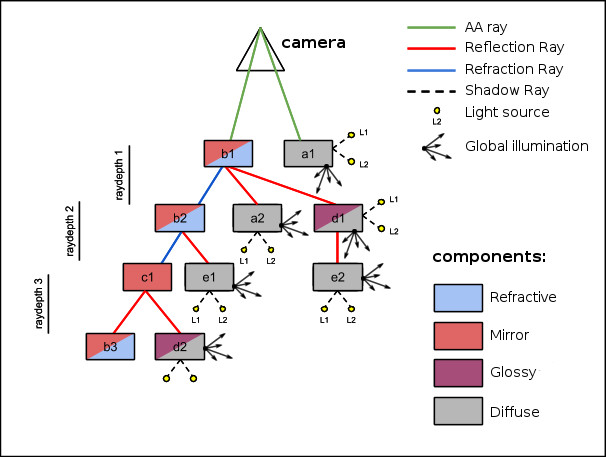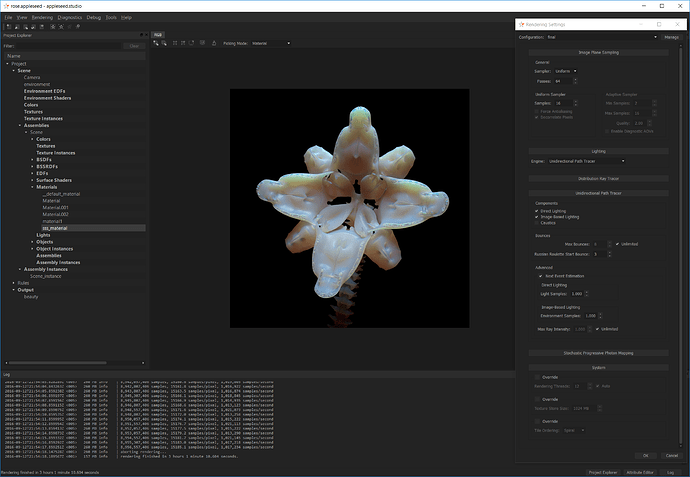Is this Debate? Why do people just talking about Yafaray is gone project? As I know its Veteran in render engines (similar to V-Ray), but it is not “abandoned” one. Just waiting his “New Devs”. BI material style based? Yes, it is, but its not really poor thing than unstable if it was been.
Since Cycles came out, everyone jumped on that bandwagon and forgot about other rendering engines. I turn to Yafaray at times, since it is faster than Blender internal, uses adaptive sampling to speed up rendering, has several path tracing options, gives awesome caustics results, its global illumination is on par with, or in some cases surpasses some commercial engines that I use and has simplified material setups. However it does lack some things that I have come to rely on to speed up work, one of which is an interactive preview. The materials could be a little less technical in the UI and more artist centered, but you can get used to it with study. Again, I would use it much more if there was and interactive preview so materials, lights and renders in general could be setup faster.
I really do like Yafaray quite a lot. It’s a shame development has been reduced to, well pretty much David. He does great work, but probably would do more with help.
I think nobody has got the last word about what becomes standard or a superior technology in raytracing and Corona for instance has dispelled some mainstream myths about GPU pathtracers, which are useful but just in specific use cases. The only thing sure I have is that nothing beats a good algorithm, even the most expensive GPU card. Also it is not good to judge other free open source projects using Blender metrics because Blender is probably a special case. The YafaRay project has recovered several times from phases without development (about three times) and Blender integration has always shaped our project for good and for bad, the nodes system is an example of that. Also I thing that new algorithms will make our projects obsolete at anytime, and they will be based on superior maths and not in more brute force capabilities.
Also it is quite ironic that YafaRay has been doing PBR style materials since 2005, now it just becomes mainstream thanks to Substance painter and Marmoset toolbag.
If there’s anything that doesn’t help Yafaray as a project more than anything outside of the website, it’s the fact that a handful of important shading features such as SSS are filed under the nice-to-have category rather than given a high priority. Yafaray has about everything needed for arch-vis and hard-surface objects, but falls a bit short in terms of rendering anything organic (the first statement is not my opinion, but based on a post from Alvaro a few years back). Sure, there might be plenty of speed, but you need more than fast rendering to give professionals a reason to use it.
Also, I do admit that I haven’t browsed through the website in a while, hopefully you guys have also either updated or archived the pages woefully out of date yet remaining in prominent places.
The problem is that more times the people only see in the ‘trunk’, without see into ‘branchs’ 
Branches don’t always get merged back in (either the project doesn’t get completed or it fails to pass the review stage).
I don’t make use of Blender branches so much when downloading builds for this reason.
We still talking how Yafaray is, not added any stuffs to the thread. So, if we discussioning about how it is then we’ll never do something useful but also “discussioning infinitive”. Well, just smile and post something useful. 
P.s.: Sorry for off-topic message. @povmaniaco, what about BDPT improvements?
Odilkhan Yakubov: Not more off-topic, please. You already know where to see those improvements. Obviously Ace Dragon does not. 
Hi
The problem of the SSS shader coded during the GSOC 2010 for the YafaRay project is that like many other GSOC projects is highly experimental with little practical application. Fast convincing SSS shader is a very difficult matter, even there was a thread here about how the skin shader of the two digital caracters in the Rogue One were little convincing and I agree with that, and that was rendered with state of the art production tools. Anyway we had little hope we would ever get multipass rendering and now we have it, maybe that can be fixed too. But no GSOC anymore, we are done with that.
However, there was no indication as to what SSS algorithms they were using (the new ray-traced algorithm developed by Disney for instance is far better quality than the old dipole-based algorithm). Just compare SSS shading in BI and Cycles to see an example you can test yourself.
I think I read the Rogue One team used Vray for a lot of shots, so it does hint that the latest advances may not have been used (and of course the harsh tonemapping did not help either).
That’s a nonsense reason to not have good SSS; SSS is a well-known and researched phenomena in computer graphics these days, and there are multiple fantastic open papers out there for high quality expressions.
Implementation and the uncanny valley are completely different issues. Avoiding adding a vital render feature because someone might use it to make something that doesn’t look real is a pretty disingenuous dodge of a very real critique.
Well that’s not exactly what I meant with my message but whatever !
BTW can you post links to those SSS papers please we might take a look !
Going back to the original topic of the thread, today we have new server that will help to solve the issues we have had during the past months. I have also finished a ‘tonemapping’ section in my Grey18 workflow tutorial, please take a look here.
I also have a tutorial going on which is still missing some very important sections but it has useful information already, so I am making it public.
http://www.yafaray.org/node/760

This tutorial and the one posted in the previous message is basically the workflow I use in all the work I do with YafaRay, all professional stuff. I use YafaRay quite often, almost every day and people like the result. I miss several things in YafaRay, for instance a biased algorithm for our pathtracer and for IBL sampling like irradiance cache or similar, Final gather for SSPM working on adaptive passes, differential thresold for adaptive sampling, making it easier working out materials, independent relief mapping for each specular layer in a coated glossy material, importance photon shooting for light sources and better microfacet specular models, etc.
Ace, Matt, it doesn’t matter.
Alvaro, juancarlos, thanks.
Alvaro,
That’s a great starting point, as are the recent Christensen papers available from Pixar research. And then, of course, the code of Cycles, Appleseed, and Mitsuba can’t be beaten in terms of functional examples.
The PBRT book (and code) in the 3rd edition also covers Solid Angle’s BSSRDF importance sampling. That and Burley’s normalized BSSRDF are IMHO the most practical methods right now and are implemented in Cycles.
Haven’t gotten to the SSS chapter in 3rd Edition yet. I’m pumped to read it now that I know the details.



